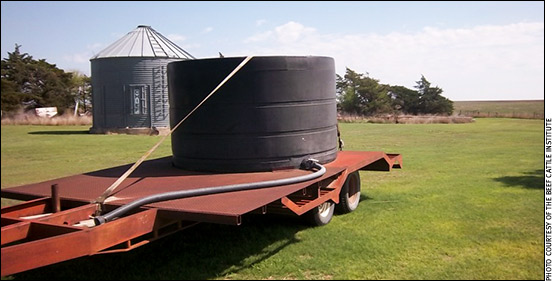
Plastic tanks used to haul fertilizer, nonprotein nitrogen or similar substances are difficult, if not impossible, to clean out, Steve Ensley stressed.
Use Fresh Water Tanks
No matter how well you clean it, a tank used to store or haul chemicals shouldn’t be used to haul water to thirsty cattle.
Hot, dry summers often mean hauling water for cattlemen across the country. Whether the windmill quit or the pond went dry, it’s the time of year when producers roll out plastic tanks to ensure their cattle have access to water.
Every year, Steve Ensley, veterinary toxicologist with the Veterinary Diagnostic Lab at Kansas State University, gets the same call: A producer hauled water, and now he’s got dead cattle. After a particularly devastating loss in western Kansas earlier this year, Ensley stressed the importance of delivering clean, chemical-free water to cattle.
Use a new tank
His bottom line? Use a brand new tank. Often, producers use the same polypropylene tank to haul water that is used for hauling fertilizer, herbicide or other farm-use chemicals.
“If those tanks have ever been used to haul fertilizer, nonprotein nitrogen or similar substances, they’re difficult, if not impossible, to clean out,” he stressed. “You need to have a dedicated tank, and all you use it for is animal drinking water.”
“Any fertilizer or herbicide chemicals can leach into the plastic fibers and can contaminate any water with which the tank is filled. There’s no way to scrub, steam or clean it out,” Ensley said.
One of his latest cases involved a tank previously used for nitrogen and urea. After 18 hours without water, cattle drank excessively from the contaminated water, resulting in several deaths.
“It’s very common,” Ensley said. “I see it every year. It’s worth the investment to get a tank dedicated to only hauling water.”
Symptoms of toxicity
Nitrates cause an interference with an animal’s ability to oxygenate.
“You see varying degrees of oxygen deprivation from just ataxic or wobbly, to down cattle and serious respiratory issues,” he said.
Urea compounds cause hyper-ammonia issues. Ensley said the compounds can cause symptoms similar to grass tetany toxicity. Cattle may seem agitated or easily provoked, and can die within 30 minutes of ingesting water contaminated with urea compounds.
“If that’s the only source of water the animals have and it’s contaminated, it’s not a good idea,” Ensley said. “We want to try to provide them with the best quality water we can. Hauling water in a tank that’s been used for something else on the farm is just not a good idea. I continually see this and in most all cases, the animals lost would have purchased at least one new tank. It’s just not worth the risk.”

Editor’s Note: This article is reprinted with permission from the Beef Cattle Institute Research Update.






